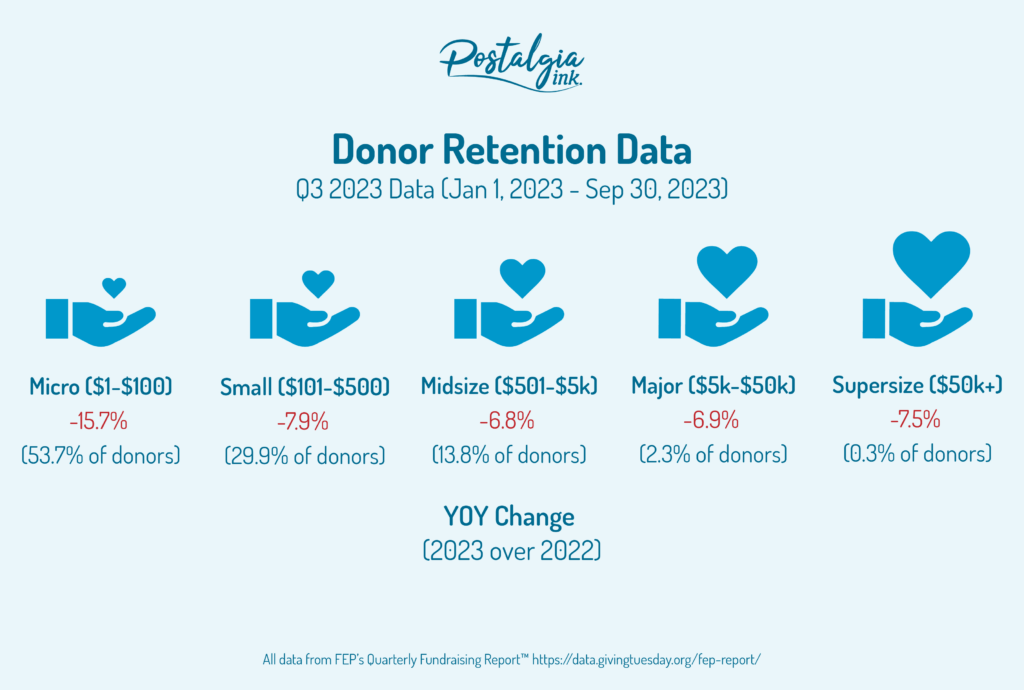Elevating Nonprofit Success: Navigating Donor Retention in 2024
By: Ilan Mann
June 15, 2022INTRODUCTION
In the ever-evolving landscape of nonprofits, the perennial debate persists: is it more financially effective to spend on secure new donors or on retaining existing ones? While the consensus often tips in favor of acquiring fresh supporters, the undeniable truth is that maintaining a robust donor retention rate is equally pivotal for long-term success.
Nonprofits that boast high donor retention rates nurture a loyal community, fostering consistent returns year after year. Conversely, those grappling with lower rates find themselves stuck in a cycle of perpetual donor acquisition, consuming more time, money, and effort in the process.
Let’s delve into the art of reshaping your fundraising strategy to cultivate a thriving donor retention approach while considering the latest trends and challenges from 2023.
Key Topics
1. What are Current Challenges in the Nonprofit Landscape?

1. What are Current Challenges in the Nonprofit Landscape?
Neglecting donor retention efforts can result in unfavorable outcomes that no nonprofit willingly faces. According to FEP’s Quarterly Fundraising Report™, in Q3 of 2023 there was a -7.3% decrease in donor participation that was driven by low retention and acquisition rates. Donor retention has been steadily decreasing after the rise in donor participation in 2020 and early 2021. This alarming trend underscores the urgency for nonprofits to fortify their strategies and resist this decline.
The attrition rate, representing the pace at which donors are lost, significantly impacts the size of your donor database each year. Equally concerning is the reality that when donors cease contributions, the likelihood of their return diminishes drastically.
It’s crucial not to underestimate these challenges. Instead, always assume that if a first-time donor doesn’t contribute a second time, the odds of their return are slim—data supports this trend.
2. How to Craft a Robust Donor Retention Strategy?
Building an effective donor retention strategy doesn’t have to break the bank, especially considering the financial constraints nonprofits often navigate. Here are three key elements to fortify your donor retention efforts in 2024.
Rely Heavily on Proven Data
Effective donor management hinges on quality data. Identifying where to focus your efforts for maximum impact and tracking retention and attrition rates become seamless with the assistance of donor management software.
Put a Special Focus on First-Time Donors
The early stages of a donor relationship are pivotal. Data underscores the importance of retaining first time donors, emphasizing the need for creative approaches that align with your nonprofit’s mission to encourage subsequent contributions. Thank you cards and newsletters are a must!
Choose Tactics You Can Execute Well On
Amidst the myriad of donor retention tactics, avoid overwhelm by selecting a few that align with your strengths. Don’t just go through the motions—stand out by executing chosen tactics with sincerity and authenticity.
3. What are Some Popular Donor Retention Tactics?
What you should NOT do is go through the motions so that you can check them off your list.
Some popular donor retention tactics, tailored for 2024, include:
- Thank donors promptly
- Segment communications effectively
- Provide updates on outcomes
- Incorporate personal touches through phone calls and handwritten notes
- Conduct donor surveys
- Offer recurring gift options
Read our article on best practices for increasing donor loyalty
CONCLUSION
The secret to boosting donor retention lies in the unique relationships your nonprofit builds with each supporter. Understanding your donors, their preferences, and actively working to maintain these connections are pivotal components of a successful donor retention strategy.
Explore how Postalgia can help deepen your donor relationships by sending heartfelt thank-you cards. Our services encompass design, copywriting, list hygiene, mail preparation, handwritten letters and a comprehensive suite of direct mail production services, ensuring your gratitude resonates with every recipient. As we face the challenges from declining donor retention rates in 2023, let’s collectively strive to reverse this trend and secure a brighter future for nonprofit success in 2024.
